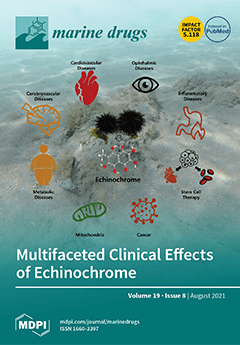Six new triterpene tetra-, penta- and hexaosides, chitonoidosides A (
1), A
1 (
2), B (
3), C (
4), D (
5), and E (
6), containing one or two sulfate groups, have been isolated
[...] Read more.
Six new triterpene tetra-, penta- and hexaosides, chitonoidosides A (
1), A
1 (
2), B (
3), C (
4), D (
5), and E (
6), containing one or two sulfate groups, have been isolated from the Far-Eastern sea cucumber
Psolus chitonoides, collected near Bering Island (Commander Islands) from the depth of 100–150 m. Three of the isolated compounds (
1,
3 and
6) are characterized by the unusual aglycone of new type having 18(20)-ether bond and lacking a lactone in contrast with wide spread holostane derivatives. Another unexpected finding is 3-
O-methylxylose residue as a terminal unit in the carbohydrate chains of chitonoidosides B (
3), C (
4), and E (
6), which has never been found before in the glycosides from holothurians belonging to the
Psolidae family. Moreover, this monosaccharide is sulfated in the compound
4 into unprecedented 3-
O-methylxylose 4-
O-sulfate residue. Chitonoidoside C (
4) is characterized by tetrasaccharide moiety lacking a part of the bottom semi-chain, but having disaccharide fragment attached to C-4 of Xyl1. Such architecture is not common in sea cucumber glycosides. Cytotoxic activities of the compounds
1–
5 against mouse and human erythrocytes and human cancer cell lines: adenocarcinoma HeLa, colorectal adenocarcinoma DLD-1, and leukemia promyeloblast HL-60 cells were studied. The cytotoxic effect of chitonoidoside
d (
5) was the most significant in this series due to the presence of pentasaccharide disulfated sugar chain in combination with holostane aglycone. Surprisingly, the glycosides
1 and
3, comprising the new aglycone without γ-lactone, demonstrated similar activity to the known compounds with holostane aglycones. Chitonoidoside C (
4) was less cytotoxic due to the different architecture of the carbohydrate chain compared to the other glycosides and probably due to the presence of a sulfate group at C-4 in 3-
O-MeXyl4.
Full article






